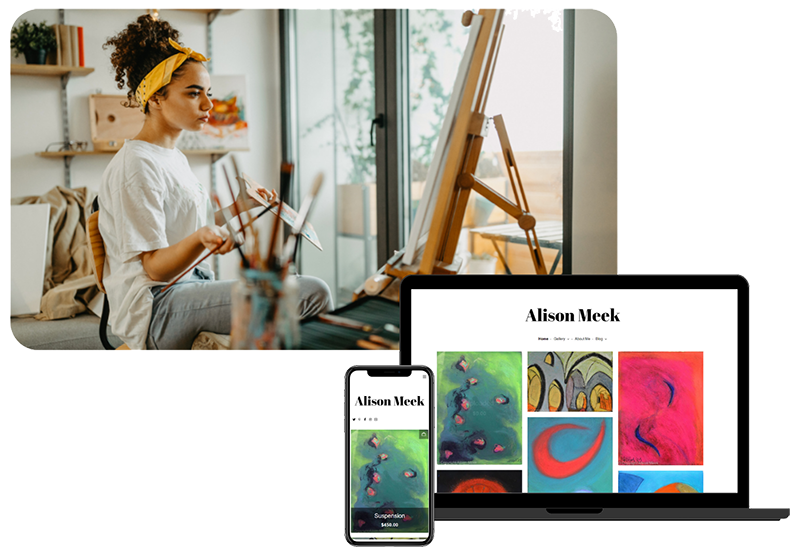Hello! In Part 4 in our ‘Exhibiting your Art’ blog series, we’ll be talking about submitting to group shows, open calls, and how to make sure you’re not wasting your valuable creative time (when you could be concentrating on making art!) So far this 5-part series has covered getting started, holding your own exhibition, and working with commercial galleries, and marketing and promotion for exhibitions.

Why submit to group shows?
Submitting to an open call can be a valuable and rewarding process. Here are a few reasons why…
- It gets you thinking about your work. Often open calls require you to write a statement, which forces you to reconsider and contextualise your current practice – something that is usually easily avoided, yet an extremely helpful process.
- It gets people seeing your work, even if it doesn’t get selected! Judges on open calls are often established curators, gallery owners, and other artists, so submitting to one is guarunteed to get your work seen by some influential people.
- There are some amazing opportunities out there, and if your work is selected there can be fantastic rewards, such as selling your work, exhibiting alongside established and internationally recognised artists, and the chance to show your art to a whole new audience. Perhaps the most prestigous of open calls is the Royal Academy Summer Exhibition (which is on now), where anyone can submit work, no matter how established you are. So you could be exhibiting on the same walls as Hockney, Kapoor or Emin, and have your work seen by thousands of visitors every day!
- As opposed to organising your own exhibition, once you have made a successful application, often the difficult part is done. You won’t be in charge of marketing, or organising a private view, so you can spend more time creating your work. Of course, there will always be logistical things to consider, such as delivery of the work and deciding on pricing, and you will probably want to spread the word to family and friends too (this is where the magic of social media comes into practice!)
- Networking – if you’re work is selected for an exhibition, you will start liaising with the curators and gallery organisers, all of whom you should ensure remain on you future contacts database. Likewise, the private view will give you the chance to meet other artists and influential people.
Hanging the Royal Academy Summer Exhibition
Why do galleries set up open calls?
As we mentioned in part 3 (working with commercial galleries), curators and gallery owners don’t tend to enjoy unsolicited proposals. They simply don’t have time to look through endless emails with numerous attachments. By setting up an open call, a curator is saying ‘I have time now, let me see what you’ve got!’ So make the most of it! It’s also a chance for curators to discover new work, which they may not find simply through their own research and network.
How to know whether to apply
It’s important to make sure you’re not wasting your time with open calls. Some opportunities are quite specific, and may involve spending considerable time writing proposals, re-writing your artist statement, adjusting your portfolio and so on. Here are some tips on how to limit your time wastage:
- Make sure you are eligible! Occasionally you might spot an exhibition opportunity that gets you so excited, you forget to read the basic requirements. For example, many open calls specify an age limit, a limit on how many years you have been practicing, or whether students are eligible are not. Make sure you read the fine print before starting, as to avoid disappointment further down the line.
- Think about whether the show you’re applying for is really right for you. Sometimes, although there might not be eligibility requirements, there may be a specific theme or idea that the curator wants you to respond to, and they will often need to see how this is relevant to your practice. Be realistic – if you have never even thought about creating work that responds to say, cultural politics, then creating an idea from scratch for an exhibition proposal might not be the best use of your time. There are so many opportunities out there, and no one can apply for them all, so be selective and spend longer on each one!
- Save everything, and create a filing system you can easily return to if similar opportunities return – there’s no point rewriting a statement if you can use an exisiting one.
- Keep track of your applications, and make a record of any that you hear back from (good or bad feedback), and what you learned from each one. After a while, patterns will begin to form, and you’ll start to learn about what works and what doesn’t.
- Follow the rules. If a submission asks for a portfolio link, don’t send it as an attachment in an email, as this will most probably clog up their inbox and annoy them. If you don’t have a website, there are better ways to send large files, such as using a service like We Transfer or You Send It. The recipient recieves a link to your file, and it even lets you know when they’ve downloaded it… handy!
There’s a fee – should I apply?
There have been many heated debates about this subject. Some open calls we’ve seen ask for the artist to pay £15-£20 per artwork submitted, so if you’ve got a few pieces, this will soon add up to one expensive outlay! Particularly as you can’t be sure you will actually be selected.
Everyone has different opinions on whether paying fees for open submissions is right or wrong. A lot of artists will set themselves a monthly budget, and within that they will include an allowance for submitting to open calls. It is up to the artist how much this is, so it’s important to workout a realistic amount and stick to it. Again, this is where the tips above come into play, as it’s important to weigh up whether something is worth applying to before you splash out on something that might not be relevant.
There are of course plenty of free opportunities out there, so if you’re not prepared to pay for open calls, you won’t be twiddling your thumbs!
Getting the gig
There’s no telling what the judge will be looking for in your work, but there are some basic rules you should follow when applying to artist calls. Here are some ways to make sure you aren’t missing out on the details:
- Always provide names to your artwork
- Give important details such as dimensions and media, particularly if it is an online submission
- If sending actual artworks or prints, make sure they are well presented and carefully packaged, with complete labelling and additional information attached
- If sending online submissions, or postal submissions with data discs, ensure the photographs truly represent your artwork. For advice on how to photograph your artwork, see this blog post from a while back (scroll down to the ‘good image’ section). Also make sure your files are correctly formatted so they can be viewed on any computer.
- Perfect your artist statement and biography. For more advice on these, see this article. These may need to be re-written slightly for each application, much like sending CVs out to job applications.
- Make sure you also include an artist CV with all relevant exhibitions, residencies, and commissions (exclude jobs outside of your artistic practice).
Getting over the setbacks
Submitting to an art opportunity can be extremely hard work, and sadly, with the sheer amount of artists applying, you are always going to get knock backs and rejections. A lot of the time, this won’t be down to the quality of your work, but the relevance of your application. It’s important to remember that with each application, you’re learning something about your practice, gaining more exposure, and developing your ideas. Keep going… practice makes perfect!
Where are open calls advertised?
There are plenty of websites out there dedicated to connecting artists to open calls. Here are a few of the best:
- ArtQuest (a great resource with a selection of the best opportunities)
- Ideas Tap (more design/film/performance related)
- Wooloo (great for residencies and opportunities around the world)
- TransArtists (international residencies)
- A-N (members only)
Are you an artist with experience of what makes a great open call application? Do you know what works and what doesn’t? Please feel free to share any advice in our comments section below.
Next read: marketing and promotion for exhibitions.









